Abstract
This study was designed to provide direct information on the in vivo metabolism in man of free (unesterified) cholesterol in the major lipoprotein classes. Five human subjects were administered one or two (simultaneous) of the following; [2-14C] mevalonic acid, high density lipoprotein (HDL)-free [14C] cholesterol, low density lipoprotein (LDL)-free [14C] cholesterol, and very low density lipoprotein (VLDL)-free [3H]cholesterol. Blood was then obtained at frequent intervals for at least 9 h, and the α(HDL) and β(LDL + VLDL) lipoproteins were quickly separated by heparin-manganese precipitation to prevent ex vivo exchange of free cholesterol. After the administration of [14C]mevalonic acid the specific activity (disintegrations per minute/micromole) of free cholesterol in the α- and β-lipoproteins increased for 3 h. During this period the α-free cholesterol specific activity was higher than the β specific activity. After administration of VLDL and LDL labeled with free cholesterol, the α-free cholesterol specific activity reached a peak value within 20 min, at which time it was considerably lower than the β-free cholesterol specific activity. When HDL labeled with free cholesterol was administered, a precursor product relationship was observed between the α-free cholesterol (precursor) and β-free cholesterol (product) specific activities.
A multicompartmental model was developed that contained the simplest structure necessary to fit all of the data obtained. The kinetic analysis revealed the presence of extensive exchange (20-85 μmol/min) of free cholesterol between HDL and a tissue pool(s) enriched with newly synthesized free cholesterol. It was found that virtually all (>95%) of the free cholesterol in the β-lipoproteins (LDL+VLDL) cycles directly through HDL. The free cholesterol in LDL appears to behave in the same fashion as the free cholesterol in VLDL.
The results show that there are marked differences in the kinetic behavior of the free cholesterol fractions of α- and β-lipoproteins. There is extensive recycling of free cholesterol between HDL and tissue pools, and between HDL and the β-lipoproteins; this recycling has been quantitated. The findings support the view that in vivo, the free cholesterol in HDL plays a central role in exchange reactions and in the vascular-tissue cholesterol transport system.
Full text
PDF
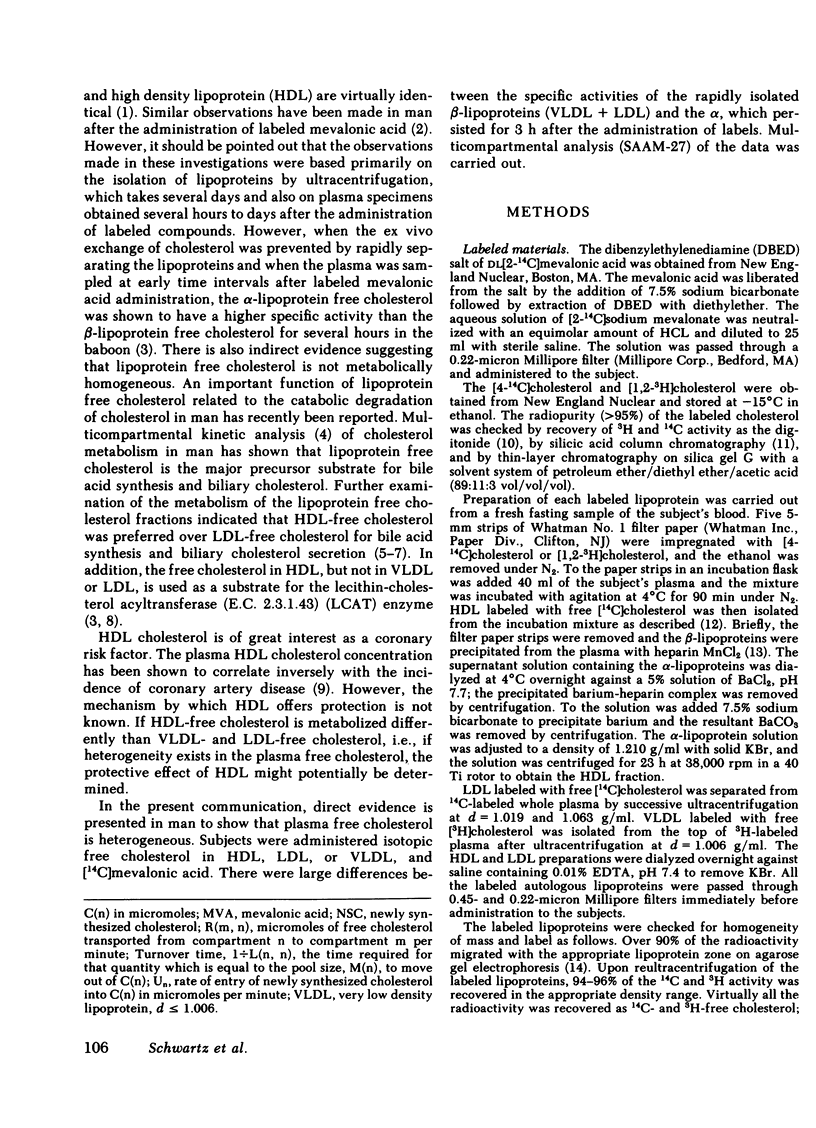

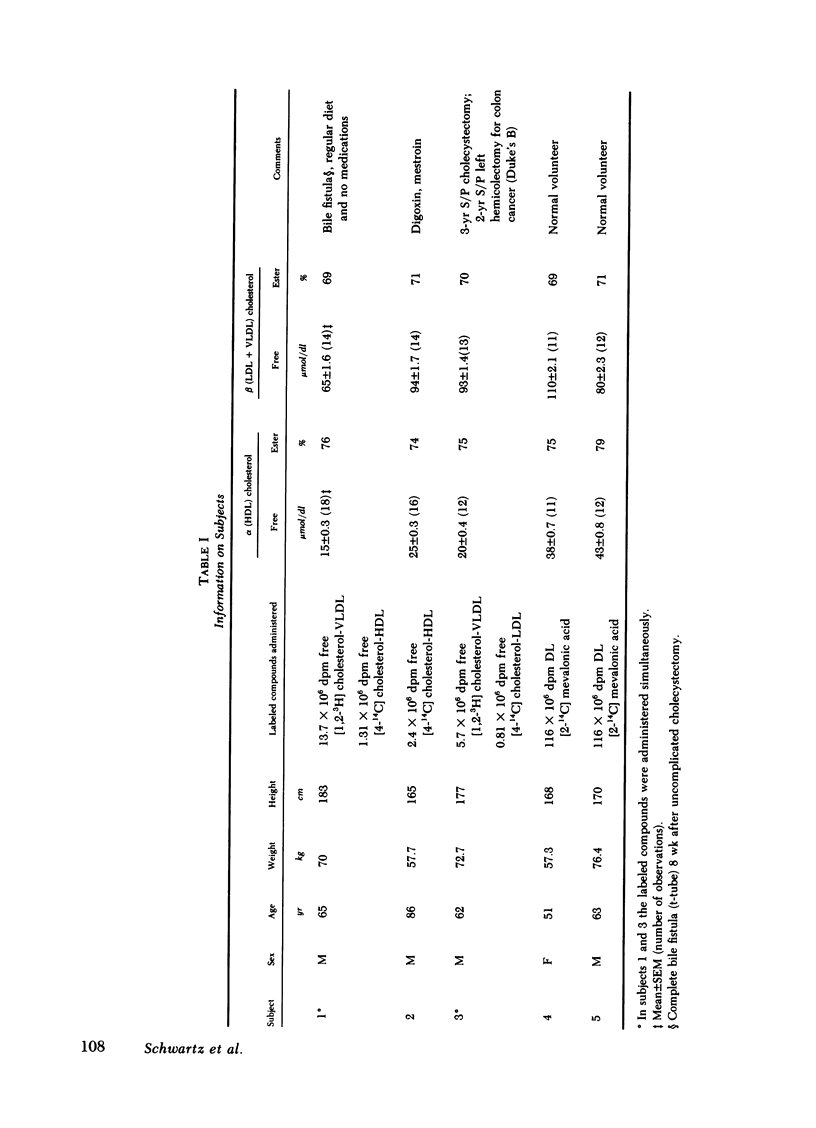


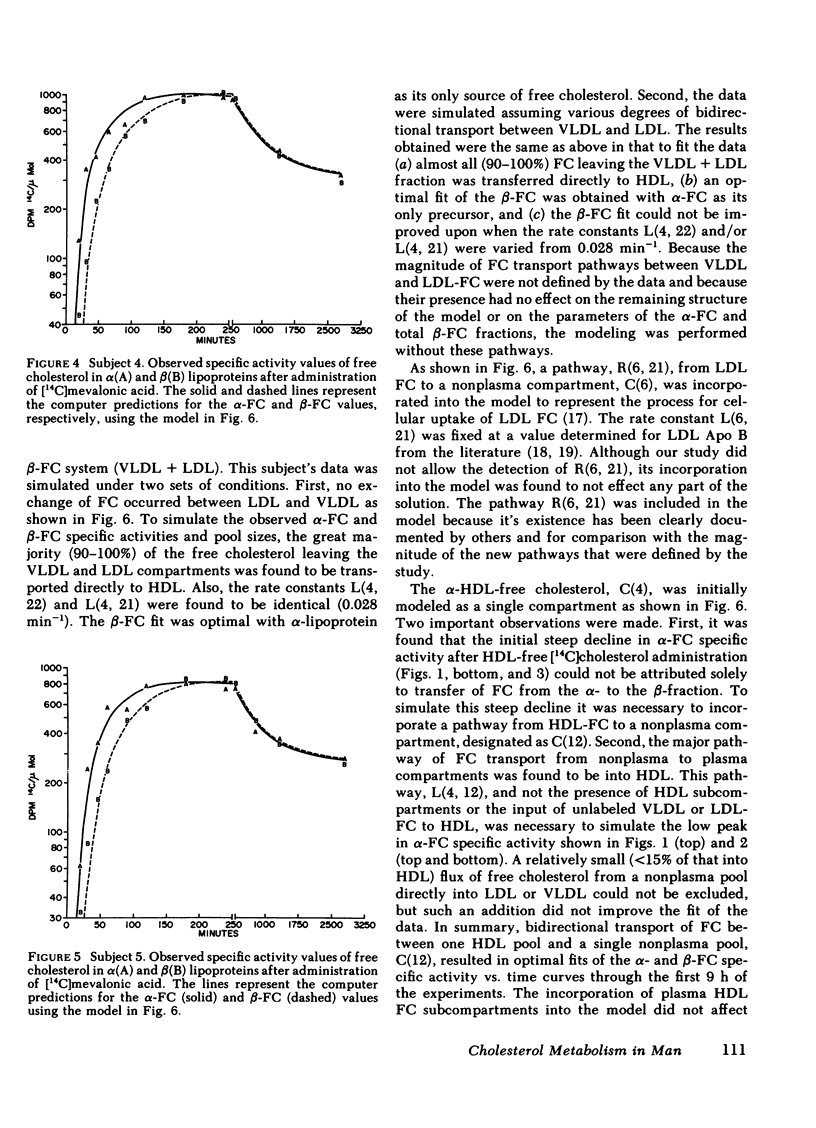
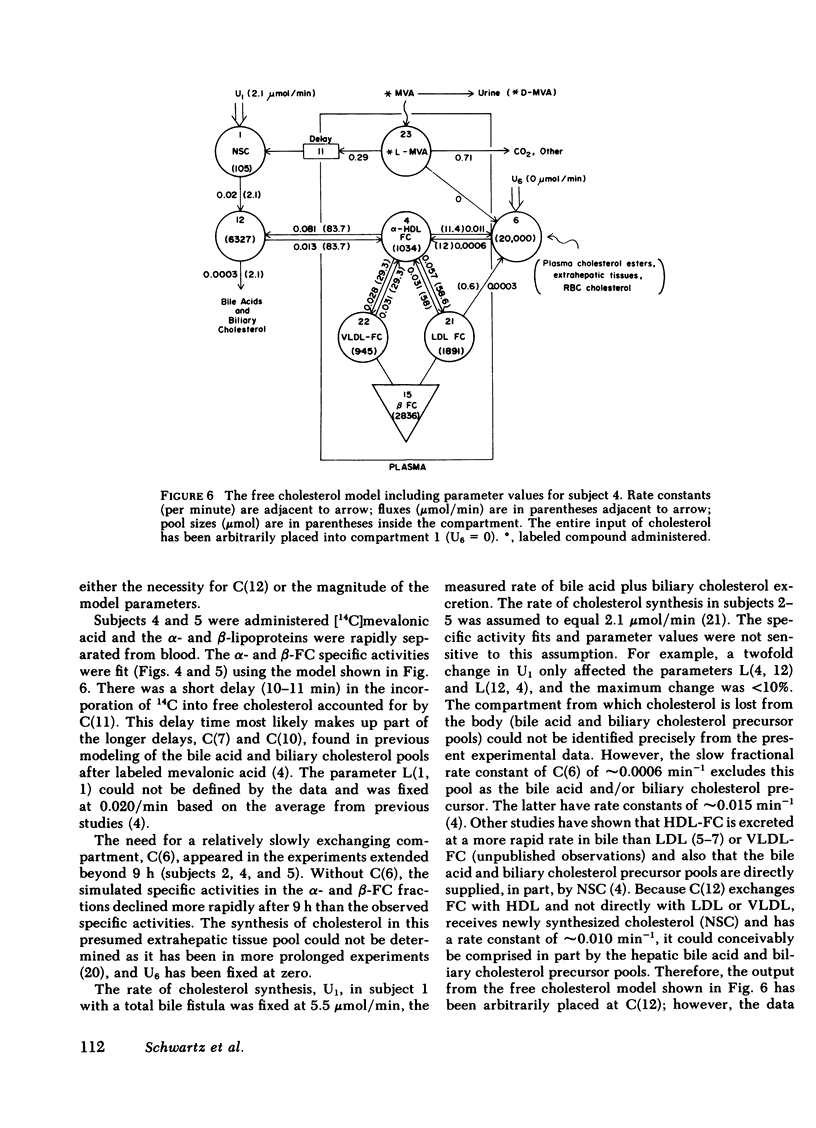

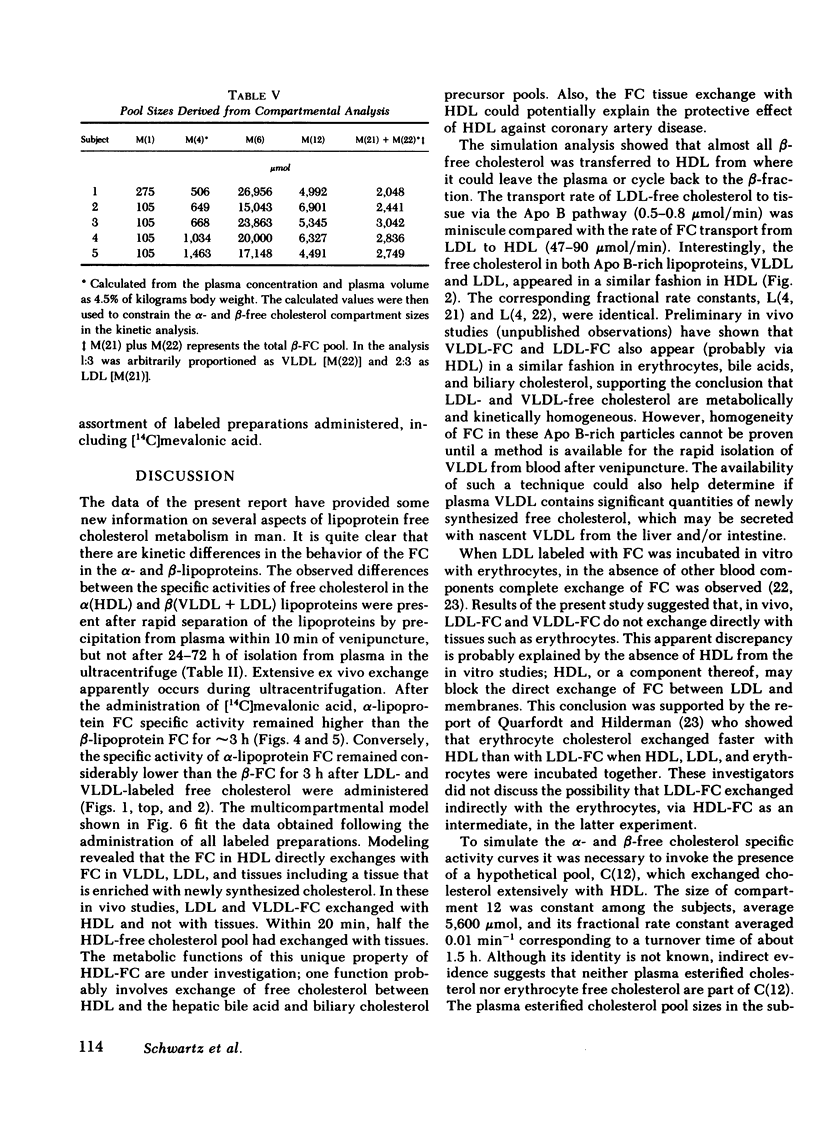
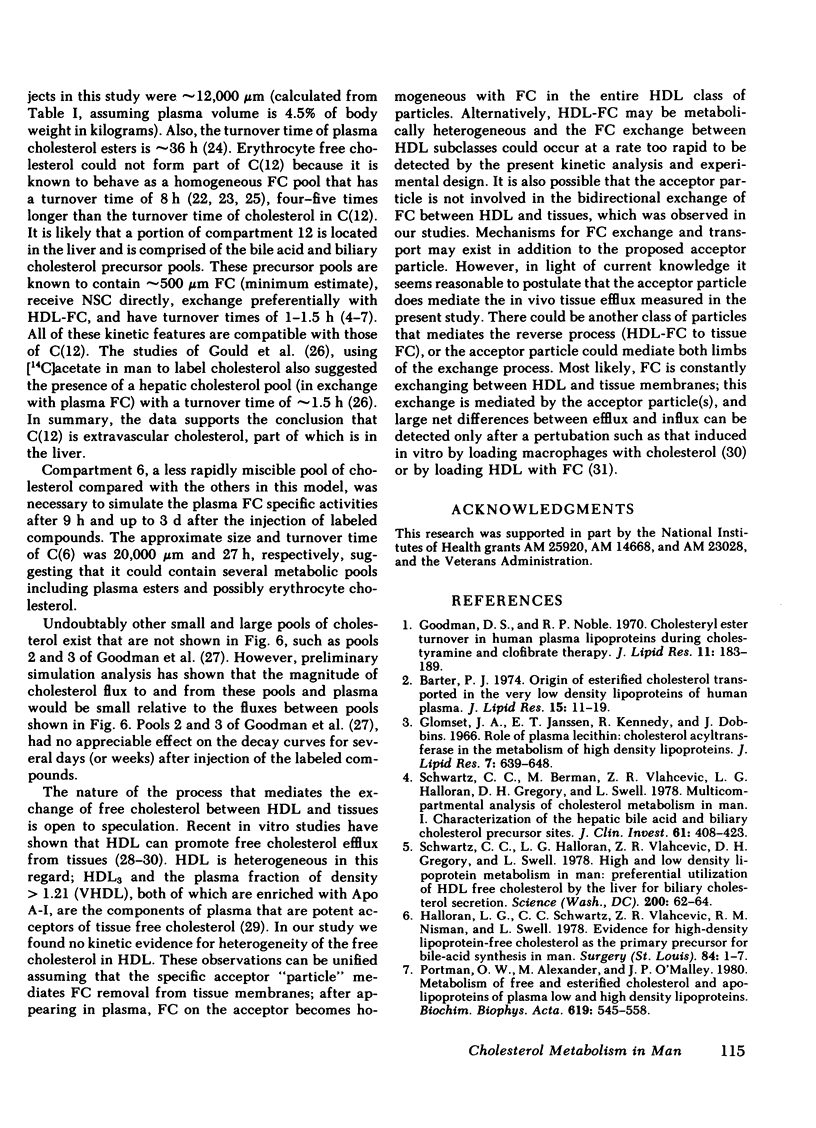
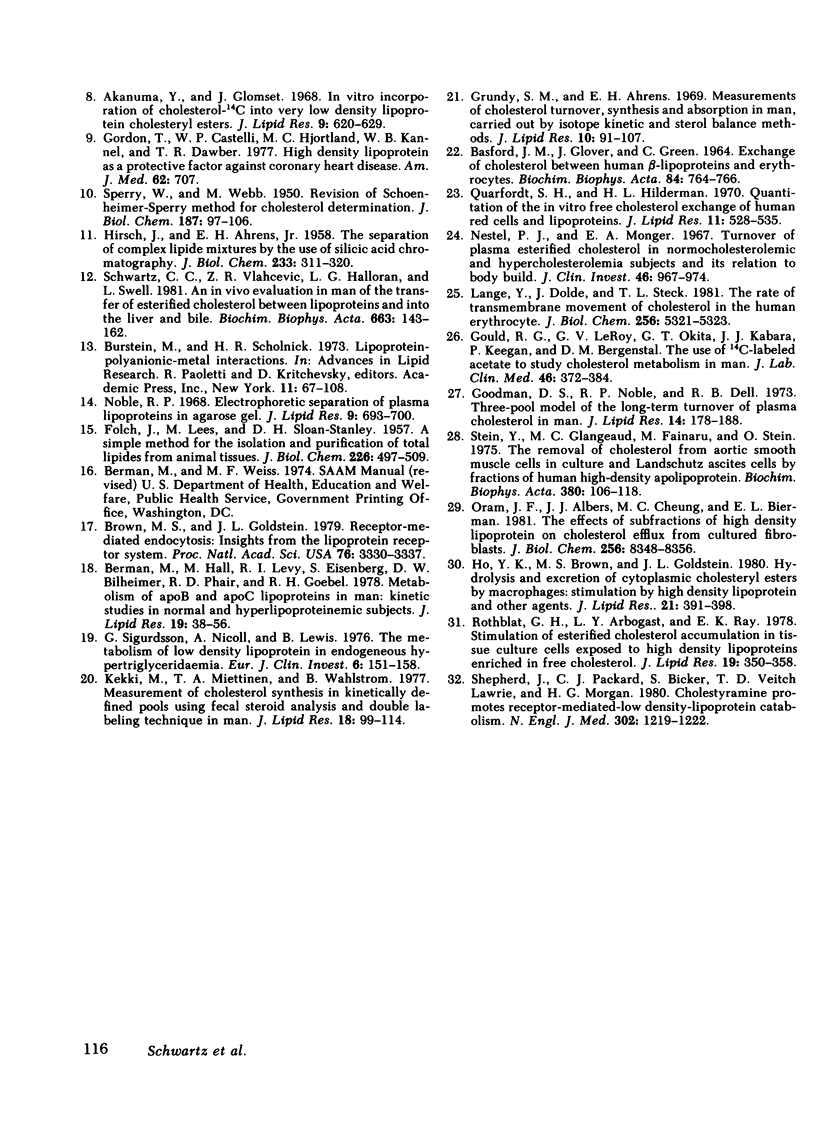
Selected References
These references are in PubMed. This may not be the complete list of references from this article.
- Akanuma Y., Glomset J. In vitro incorporation of cholesterol-14C into very low density lipoprotein cholesteryl esters. J Lipid Res. 1968 Sep;9(5):620–626. [PubMed] [Google Scholar]
- BASFORD J. M., GLOVER J., GREEN C. EXCHANGE OF CHOLESTEROL BETWEEN HUMAN BETA-LIPOPROTEINS AND ERYTHROCYTES. Biochim Biophys Acta. 1964 Dec 2;84:764–766. doi: 10.1016/0926-6542(64)90039-3. [DOI] [PubMed] [Google Scholar]
- Barter P. J. Origin of esterified cholesterol transported in the very low density lipoproteins of human plasma. J Lipid Res. 1974 Jan;15(1):11–19. [PubMed] [Google Scholar]
- Berman M., Hall M., 3rd, Levy R. I., Eisenberg S., Bilheimer D. W., Phair R. D., Goebel R. H. Metabolsim of apoB and apoC lipoproteins in man: kinetic studies in normal and hyperlipoproteininemic subjects. J Lipid Res. 1978 Jan;19(1):38–56. [PubMed] [Google Scholar]
- Brown M. S., Goldstein J. L. Receptor-mediated endocytosis: insights from the lipoprotein receptor system. Proc Natl Acad Sci U S A. 1979 Jul;76(7):3330–3337. doi: 10.1073/pnas.76.7.3330. [DOI] [PMC free article] [PubMed] [Google Scholar]
- Burstein M., Scholnick H. R. Lipoprotein-polyanion-metal interactions. Adv Lipid Res. 1973;11(0):67–108. [PubMed] [Google Scholar]
- FOLCH J., LEES M., SLOANE STANLEY G. H. A simple method for the isolation and purification of total lipides from animal tissues. J Biol Chem. 1957 May;226(1):497–509. [PubMed] [Google Scholar]
- Glomset J. A., Janssen E. T., Kennedy R., Dobbins J. Role of plasma lecithin:cholesterol acyltransferase in the metabolism of high density lipoproteins. J Lipid Res. 1966 Sep;7(5):638–648. [PubMed] [Google Scholar]
- Goodman D. S., Noble R. P. Cholesteryl ester turnover in human plasma lipoproteins during cholestyramine and clofibrate therapy. J Lipid Res. 1970 May;11(3):183–189. [PubMed] [Google Scholar]
- Goodman D. S., Noble R. P., Dell R. B. Three-pool model of the long-term turnover of plasma cholesterol in man. J Lipid Res. 1973 Mar;14(2):178–188. [PubMed] [Google Scholar]
- Gordon T., Castelli W. P., Hjortland M. C., Kannel W. B., Dawber T. R. High density lipoprotein as a protective factor against coronary heart disease. The Framingham Study. Am J Med. 1977 May;62(5):707–714. doi: 10.1016/0002-9343(77)90874-9. [DOI] [PubMed] [Google Scholar]
- Grundy S. M., Ahrens E. H., Jr Measurements of cholesterol turnover, synthesis, and absorption in man, carried out by isotope kinetic and sterol balance methods. J Lipid Res. 1969 Jan;10(1):91–107. [PubMed] [Google Scholar]
- HIRSCH J., AHRENS E. H., Jr The separation of complex lipide mixtures by the use of silicic acid chromatography. J Biol Chem. 1958 Aug;233(2):311–20. [PubMed] [Google Scholar]
- Ho Y. K., Brown M. S., Goldstein J. L. Hydrolysis and excretion of cytoplasmic cholesteryl esters by macrophages: stimulation by high density lipoprotein and other agents. J Lipid Res. 1980 May;21(4):391–398. [PubMed] [Google Scholar]
- Kekki M., Miettinen T. A., Wahlström B. Measurement of cholesterol synthesis in kinetically defined pools using fecal steroid analysis and double labeling technique in man. J Lipid Res. 1977 Jan;18(1):99–114. [PubMed] [Google Scholar]
- Lange Y., Dolde J., Steck T. L. The rate of transmembrane movement of cholesterol in the human erythrocyte. J Biol Chem. 1981 Jun 10;256(11):5321–5323. [PubMed] [Google Scholar]
- Nestel P. J., Monger E. A. Turnover of plasma esterified cholesterol in normocholesterolemic and hypercholesterolemic subjects and its relation to body build. J Clin Invest. 1967 Jun;46(6):967–974. doi: 10.1172/JCI105603. [DOI] [PMC free article] [PubMed] [Google Scholar]
- Noble R. P. Electrophoretic separation of plasma lipoproteins in agarose gel. J Lipid Res. 1968 Nov;9(6):693–700. [PubMed] [Google Scholar]
- Oram J. F., Albers J. J., Cheung M. C., Bierman E. L. The effects of subfractions of high density lipoprotein on cholesterol efflux from cultured fibroblasts. Regulation of low density lipoprotein receptor activity. J Biol Chem. 1981 Aug 25;256(16):8348–8356. [PubMed] [Google Scholar]
- Portman O. W., Alexander M., O'Malley J. P. Metabolism of free and esterified cholesterol and apolipoproteins of plasma low and high density lipoproteins. Biochim Biophys Acta. 1980 Sep 8;619(3):545–558. doi: 10.1016/0005-2760(80)90106-x. [DOI] [PubMed] [Google Scholar]
- Quarfordt S. H., Hilderman H. L. Quantitation of the in vitro free cholesterol exchange of human red cells and lipoproteins. J Lipid Res. 1970 Nov;11(6):528–535. [PubMed] [Google Scholar]
- Rothblat G. H., Arbogast L. Y., Ray E. K. Stimulation of esterified cholesterol accumulation in tissue culture cells exposed to high density lipoproteins enriched in free cholesterol. J Lipid Res. 1978 Mar;19(3):350–358. [PubMed] [Google Scholar]
- SPERRY W. M., WEBB M. A revision of the Schoenheimer-Sperry method for cholesterol determination. J Biol Chem. 1950 Nov;187(1):97–106. [PubMed] [Google Scholar]
- Schwartz C. C., Berman M., Vlahcevic Z. R., Halloran L. G., Gregory D. H., Swell L. Multicompartmental analysis of cholesterol metabolism in man. Characterization of the hepatic bile acid and biliary cholesterol precursor sites. J Clin Invest. 1978 Feb;61(2):408–423. doi: 10.1172/JCI108952. [DOI] [PMC free article] [PubMed] [Google Scholar]
- Schwartz C. C., Halloran L. G., Vlahcevic Z. R., Gregory D. H., Swell L. Preferential utilization of free cholesterol from high-density lipoproteins for biliary cholesterol secretion in man. Science. 1978 Apr 7;200(4337):62–64. doi: 10.1126/science.204996. [DOI] [PubMed] [Google Scholar]
- Schwartz C. C., Vlahcevic Z. R., Halloran L. G., Swell L. An in vivo evaluation in man of the transfer of esterified cholesterol between lipoproteins and into the liver and bile. Biochim Biophys Acta. 1981 Jan 26;663(1):143–162. doi: 10.1016/0005-2760(81)90201-0. [DOI] [PubMed] [Google Scholar]
- Shepherd J., Packard C. J., Bicker S., Lawrie T. D., Morgan H. G. Cholestyramine promotes receptor-mediated low-density-lipoprotein catabolism. N Engl J Med. 1980 May 29;302(22):1219–1222. doi: 10.1056/NEJM198005293022202. [DOI] [PubMed] [Google Scholar]
- Sigurdsson G., Nicoll A., Lewis B. The metabolism of low density lipoprotein in endogenous hypertriglyceridaemia. Eur J Clin Invest. 1976 Mar 31;6(2):151–158. doi: 10.1111/j.1365-2362.1976.tb00506.x. [DOI] [PubMed] [Google Scholar]
- Stein Y., Glangeaud M. C., Fainaru M., Stein O. The removal of cholesterol from aortic smooth muscle cells in culture and Landschutz ascites cells by fractions of human high-density apolipoprotein. Biochim Biophys Acta. 1975 Jan 24;380(1):106–118. doi: 10.1016/0005-2760(75)90049-1. [DOI] [PubMed] [Google Scholar]


